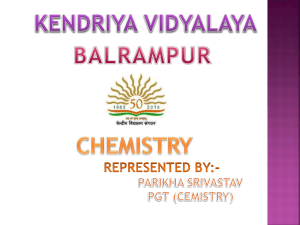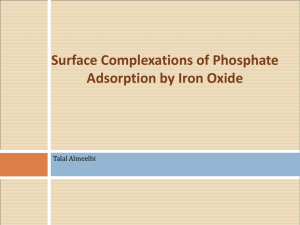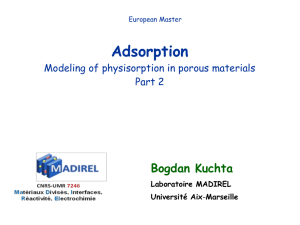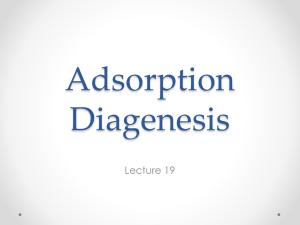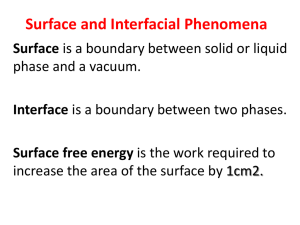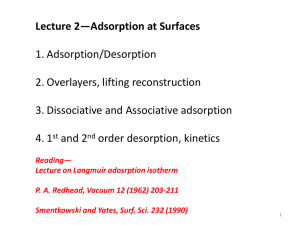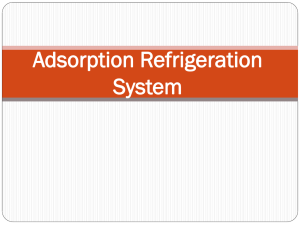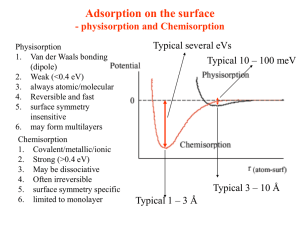Lecture 4-5-11
advertisement
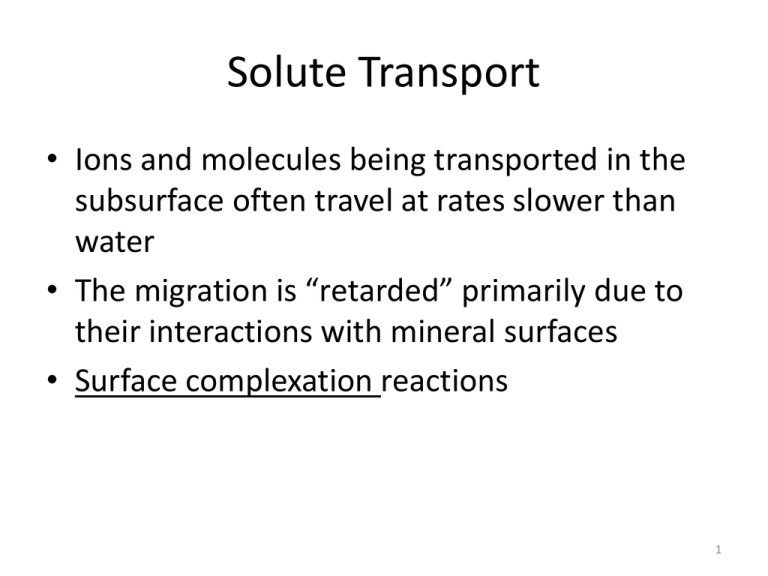
Solute Transport • Ions and molecules being transported in the subsurface often travel at rates slower than water • The migration is “retarded” primarily due to their interactions with mineral surfaces • Surface complexation reactions 1 Surface Complexation Reactions • Reactions occurring at the mineral-water interface (mineral surface) • Important for: – Transport and transformation of metals and organic contaminants – Nutrient availability in soils – Formation of ore deposits – Acidification of watersheds – Global cycling of elements 2 Sorption Processes 3 Surface Charge • Solids typically have an electrically charged surface • There are 2 main sources of surface charge • (1) Chemical reactions – pH dependent: surfaces tend to have positive charges at low pH, negative charges at high pH – For most common solid phases at natural pHs, the surface charge is negative • (2) Lattice imperfections and substitutions in the solid 4 Surface Charge • Clays: substitution or vacancy result in negative charge, which is the dominant charge • Al/Fe hydroxides adsorb both cations and anions depending on pH: Amphoteric – Low pH: positive surface charge – High pH: negative surface charge • Organic compounds can also have pH dependent charge – DOM can be important in transport of low solubility metals 5 Surface Charge • The interfacial system (surface – water) must be electrically neutral • Electrical Double Layer – Fixed surface charge on the solid – Charge distributed diffusely in solution • Excess of counterions (opposite charge to surface) and deficiency of ions of same charge as surface • Counterions attracted to the surface 6 Adsorption • Adsorption refers to a dissolved ion or molecule binding to a charged surface • All ions (including H+ and OH-) are continually competing for sites • Reversible reactions; i.e., if conditions change, the ion can desorb • Kinetically fast reactions; equilibrium often assumed 7 _ _ _ _ Solid _ _ Phase _ _ Fixed Surface _ Charge _ Counterions Adsorption _ + + + _ _ _ + Solution + _ 8 Ion Exchange • Ion exchange refers to exchange of ions between solution and solid surfaces • It differs from adsorption in that an ion is released from the surface as another is adsorbed – AX + B+ BX + A+ – X refers to a mineral surface to which an ion has adsorbed – Most important for cations, anions less so, because most mineral surfaces are negatively charged • Primarily occurs on clay minerals of colloidal size (10-3 – 10-6 mm) 9 Ion Exchange • Ion size (radius) and charge affect how they exchange – Smaller ions from stronger bonds on surfaces – Ions with more positive charge form stronger bonds on surfaces – Stronger to weaker, increasing ionic radii: • Al3+ > Ca2+ > Mg2+ > K+ = NH4+ > Na+ • Reversible reactions 10 Cation Exchange Capacity (CEC) • CEC is the capacity of a mineral to exchange one cation for another – Depends on charge imbalances in the crystal lattice • Amount of exchange sites per mass of solid (meq/100 g) – Measured in lab by uptake and release of NH4+ acetate – Not a precise measurement: pH dependent, organic coatings – Primarily applicable to clays 11 Ion Exchange Equilibrium • Mass action equation: – B-clay + A+ ↔ A-clay + B+ • Where A+ and B+ are monovalent cations – • aA-clay and aB-clay = activities of A and B on exchange sites • aA+ and aB+ = activities in solution • KAB = exchange constant – 12 Ion Exchange Equilibrium • Mass action equation can be rewritten using mole fractions in the solid phase – • XA-clay and XB-clay = mole fractions of A and B on clay – XA-clay + XB-clay = 1 • K’AB = selectivity coefficient • K’AB is not a constant because activity coefficients in the solid dependent on composition 13 Ion Exchange Equilibrium • Example: Mix 10 g of a Na-saturated smectite with CEC = 100 meq/100 g with 1 liter of water containing 20 mg/L Na+ and 20 mg/L K+ as the only cations. Assume KK+-Na+ = 2. • What will the final Na+ and K+ concentrations be? 14 Ion Exchange Equilibrium • Exchange between monovalent and divalent cation: – 2 A-clay + C2+ ↔ C-clay + 2A+ – – 15 Ion Exchange Equilibrium • Example: Suppose a solution in contact with a clay is at equilibrium and has a Ca2+ concentration = 35 mg/L and Na+ = 10 mg/L. Assume KCa2+-Na+ = 2. • What are the mole fractions (XCa2+ and XNa+) in the solid phase? 16 Monovalent-divalent effect • In fresh (dilute) waters, the dominant exchangeable cation is Ca2+ • In the ocean, the dominant exchangeable cation is Na+ 17 Cation Exchange Capacity and Groundwater Composition • Ion exchange reacts important control on groundwater chemistry • Typically CEC value in aquifer of 5 meq/100 g gives an exchange capacity of ~500 meq/L – Much larger than concentration of dissolved cations in dilute groundwater 18 Clay Mineralogy • Clays are fine-grained, crystalline, hydrous silicates with sheet structures – Phyllosilicates • Most common type of secondary mineral • Have surface charge, usually negative – Charge attracts cations to surface where they are bound by electrostatic forces – Not part of crystal structure so they can easily exchange with other ions in solution 19 Clay structure • Clays have 2 distinct sheet structures – Tetrahedral: 3-sided pyramid, 4 oxygen (O2-) atoms (or OH-) surrounding a silicon atom (Si4+) • Al3+ can substitute for Si4+, resulting in negative charge 20 Clay structure – Octahedral: two 3-sided pyramids joined at the base • Surface charge results from substitution or vacancy in central cation (usually Al, Mg, Fe) 21 Clay Structures • The tetrahedrons and octahedrons are joined to each other in sheets • The sheets join in 2 main patterns to create different clays: 2-layer and 3-layer 22 Clay Structures 23 Types of clays • 2-layer phyllosilicates – Alternating tetrahedral and octahedral layers (T:O or 1:1) – Each T and O sheet are strongly bound, while T:O’s are held together by weak van der Waal’s forces – Kaolinte (Al2Si2O5(OH)4) and serpentite (Mg3Si2O5(OH)4) groups – Relatively pure clays, close to stoichiometric – Low substitution results in low surface charge, no interlayer adsorption sites – Low CEC (kaolinite: 3-5 meq/100 g) 24 Kaolinite 25 Types of clays • 3-layer phyllosilicates – Each layer consists of 2 tetrahedrons and one octahedron (T:O:T or 2:1) – Interlayers can be adsorption sites – Smectite, vermiculite, and mica groups 26 3-Layer Phyllosilicates • Smectites – Wide interlayer spacing, easily exchange ions/ H2O – High substitution/vacancy, high CEC • CEC: 70-150 meq/100 g – Shrink/swell: as moisture content increases, more water in interlayer expands; vice versa as water content decreases • Due to type of cation – Ca2+ Na+ exchange – 2 ions for 1, increases interlayer thickness • Road salt can cause expansion of smectities next to roads due to increased Na+, resulting in engineering problems • Solution: add lime or CaCO3 to exchange Ca2+ for Na+ 27 Smectite 28 3-Layer Phyllosilicates • Vermiculite – Stronger interlayer cation bonding, slower cation exchange, higher surface charge – High CEC 29 3-Layer Phyllosilicates • Illite: most common in nature, makes up most ancient shales – 80% mica, 20% smectite – Low surface charge and CEC 30 3-Layer Phyllosilicates • Mica – Muscovite and biotite primary minerals with little substitution or vacancy, little surface charge – Similar structure to illite 31 CEC values for some clays (pH = 7.0) Clay CEC (meq/100 g) Kaolinite 3-5 Chlorite 10-40 Illite 10-40 Smectite (montmorillonite) 70-150 Vermiculite 100-150 32 Double Layer Theory • Describes the distribution of charge near a charge surface and how charge is neutralized – Stern layer: closest to surface where cations bonded by weak electrostatic forces (van der Waals) • Cations can exchange relatively rapidly and easily – Gouy layer: further from surface, thickness related to ionic strength of solution • High I, thin Gouy layer; more ions can neutralize charge over shorter distance • Low I, thick Gouy layer – Adsorption can occur in both layers 33 Double Layer Theory Net positive charge in Gouy layer 34 Double Layer Theory • The likelihood of attachment of a charged species approaches a surface is controlled by the sum of attractive and repulsive forces – Attractive: van der Waals between species of opposite charge – Repulsive: net positive charge in Gouy layer repels incoming cations – Sum of these 2 is the energy barrier (or lack thereof) needed to be overcome before a species can adsorb at the surface (Stern layer) 35 Double Layer Theory • Attachment also dependent of charge density of an ion and ionic strength – As charge density increases, attraction increases – As I decreases, Gouy layer thickness increases, repulsion moves further away from surface where attraction is weaker • Adsorption preference – Fe3+ > Al3+ > Co2+ > Ca2+ = Sr2+ > Rb+ > Mg2+ > K+ > NH4+ > Na+ > Li+ 36 Strength of adsorption • Outer (Gouy) layer complexes: cation still surrounded by sphere of hydration – Weakly bound to surface, easily exchanged • Inner (Stern) layer: no sphere of hydration, strongly bound directly to solid surface – Not easily exchange, may be effectively irreversible 37 Desorption • Reversible reactions: desorption can be caused by: – Decreasing ionic strength – Change in composition of ions in solution • Ions with higher charge density are more likely to adsorb 38 Measuring adsorption • Adsorption is measured in the laboratory by mixing a solution containing an ion with a solid phase (batch experiments) – – – – – Mix solution of known concentration with solid Agitate until equilibrium is reached Measure final dissolved concentration Initial – final = amount adsorbed Repeat at different initial concentrations • Plot data, and a graph called an adsorption isotherm is prepared – Isotherm = experiments done at constant temperature 39 Concentration adsorbed Typical Adsorption Isotherm Concentration in Solution 40 Depicting Adsorption Mathematically • Can be represented in terms of relatively simple empirical formulas, or more sophisticated models like double layer, triple layer, or constant capacitance theories • Most often, the simple empirical formulas are used because we don’t have the data for more sophisticated approaches 41 Adsorption • Since adsorption is a chemical process, we can write chemical reactions to describe it: – C + S ↔ CS • C = ion (mg/L) • S = surface (g) • CS = adsorbed ion (mg/g) – Adsorbed ion measure with respect to amount of solid 42 Linear Isotherms • Ratio of adsorbed to dissolved concentration is constant – Kd = C* / C • Kd = distribution coefficient (L3/mass) • C* = adsorbed species (massion/masssolid) • C = dissolved concentration (mass /L3) • This approach produces Linear Isotherms • Once Kd determined, calculate adsorbed “concentration” for any measured dissolved concentration 43 Concentration adsorbed Typical Adsorption Isotherm Linear portion of isotherm Concentration in Solution 44 Linear Isotherms 45 Linear Isotherms • Assumptions: – – – – Fast reaction (i.e. equilibrium quickly reached) Reversible reaction Isothermal Monolayer adsorption • Use Kd’s with great care because: – – – – – Reactions are pH, temperature, and Eh dependent Species specific, don’t account for competition Ionic strength dependent Surface dependent Can’t be universally applied 46 Langmuir Isotherms • These recognize that there are a limited number of adsorption sites for charged species – Take into account that batch experiments at higher concentration do not result in linear increases in adsorption – Plots go non-linear as they approach a maximum 47 Langmuir Isotherms Cmax* 48 Langmuir Isotherms • – α = KLang = adsorption constant (L3 / mass) – β = maximum amount of adsorption sites (mass/mass) • Also Cmax* • α and β can be obtained by plotting C/C* vs. C – Slope = 1/β – Intercept pt = 1/αβ – Still specific to species, site, water chemistry 49 Langmuir Isotherms 50 Surface Complexation Adsorption Models • Diffuse double layer, triple layer, constant capacitance • Best used to describe adsorption of metals and other cationic species 51 Surface Complexation Adsorption Models • Advantages: – Based on thermodynamics – Balanced reactions – Law of mass action – Adsorption function of pH and solution chemistry 52 Surface Complexation Adsorption Models • Recognizes that all exchange sites are not equal (inner vs. outer) • Types of exchange sites: – Aluminosilicates: crystal damage results in permanent change, “exchange” sites – Surface functional groups: usually a hydroxyl (OH-) on mineral edge • Surface charge is pH dependent • Positive and negative sites can co-exist 53 Surface Complexation Adsorption Models • So there are a variety of sites based on surface type, charge varies between types – The same surface type can have sites with different bond strength • Inner sphere complex: strong covalent bond, bonds directly to surface • Outer sphere complex: cation still surrounded by sphere of hydration; held by weaker electrostatic forces 54 Surface Complexation Adsorption Models • Writing surface complexation reactions; account for free energy based on chemical and electrostatic contributions – ≡S-OH + M2+ ↔ ≡S-OM + H+ • ≡S = surface • OH = functional group • M2+ = dissolved metal – Anion adsorption • ≡S-OH + A- ↔ ≡S-A + OH55 Surface Complexation Adsorption Models: Thermodynamically Based • Law of mass action for reaction: – This reaction accounts for chemical ΔG, but not electrostatic – Based on activity of species in bulk solution – Work is necessary to move ions through charged Gouy layer – Close to the surface, the diffuse layer has excess of cations, therefore activity (concentration) of cations increases 56 Surface Complexation Adsorption Models • The equations from these models take into account multiple site types, multiple species, changes in solution chemistry • These surface complexation models have been shown to realistically model adsorption in lab experiments – However, most lab experiments use pure mineral phases and artificial solutions. • Surface complexation models require measurement of numerous parameters on heterogeneous materials, so their field application may not be practical 57 Adsorption • Adsorption is an enormously complicated subject • It is usually very difficult to apply laboratory derived values to the field – It is very difficult to get meaningful field data on surface properties – Beware! • Changing conditions can lead to changing behavior – e.g., contaminated sites and plumes 58 Organic Compounds 59 Organic Compounds • Definition: molecules with a carbon skeleton – Usually have H and O as well • Importance: – Weathering and diagenesis – Redox conditions of water – Transport of trace metals – Contaminants: organic contaminants and biodegradation 60 Organic Compound Properties • In general, organic matter is not very soluble in water. – Organics are non-polar or slightly polar while water is highly polar • Uncharged or weakly charged • Can exist as dissolved, solid, or gaseous phases • Organic matter in water is composed of an almost infinite variety of compounds – With current technology, can determine the general chemical composition of organics, but don’t know specific formulas – The exception is anthropogenic compounds where we know exact formulas 61 Organic Compound Properties • Most dissolved organic matter in groundwater are humic acids – Substances are formed by the microbial degradation of dead plant matter, such as lignin – Very resistant to further biodegradation • Easy stuff already degraded • Explains why old groundwater still has organic matter – Defined operationally: extracted into a strongly basic aqueous solution, then precipitated from solution when pH adjusted to 1 with HCl • Remaining organics in solution = fulvic acids (dominate surface water) 62 Typical Humic Acid 63 Humic Acid Chromatography 64 Measuring Organic Compound in Groundwater • Dissolved organic carbon (DOC) (water passed through 0.45 μm filter) – Arbitrary division between dissolved and suspended material – DOC can be converted to CO2, which is how it’s typically measured – Can also measure DON and DOP • Total organic carbon (TOC) – Same procedures, but not filtered • DOC in groundwater typically low, ≤ 2 mg/L • DOC visible in water at about 10 mg/L (dark color) • Swamps and other wetlands have some of the highest DOC values, ~60 mg/L 65 Organic Compound Nomenclature • All organics have carbon skeletons with functional groups attached • Aliphatics: straight or branched chains – e.g., propane, methylpropane 66 Propane (C3H8) and Butane (C4H10) 67 Organic Compound Nomenclature • Aromatics: ring structure – e.g., benzene, naphthalene 68 A (Very) Little Humor Benzene (C6H6) Mercedes Benzene Organic Compound Nomenclature • Aromatics: ring structure – e.g., benzene, naphthalene – Multi-rings = polyaromatics (PNAs or PAHs) 70 Polyaromatics (PAHs) 71 Organic Compound Nomenclature • Aromatics: ring structure – e.g., benzene, naphthalene – Multi-rings = polyaromatics (PNAs or PAHs) – Heterocyclic: ring structure with atoms other than C in skeleton • e.g. pyridine 72 Pyridine 73


